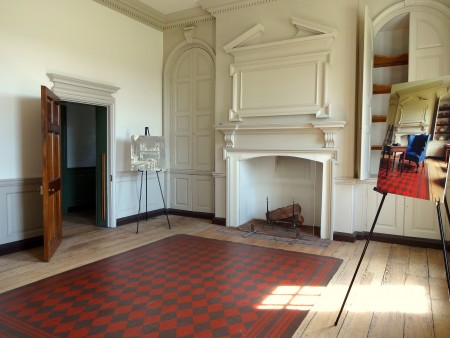It was a balmy and hot day in July. Fear and anxiety were in the air as the moving truck slowly backed up to the land-side porch and door at George Mason’s Gunston Hall. The professional art/antique movers were staged and ready. Packing materials were carefully organized. The truck stopped and the crunching of the gravel beneath the heavy tires of the 18-wheeler ceased. For a minute, all was quiet and then the large doors on the back of the trailer swung open, the metal ramp screeched out of its secure compartment, and the movers got to work.
Soon, the collections and furnishings slowly, carefully, methodically, and professionally began leaving the mansion. One by one Mason’s writing table, the Mason family silver, the portrait of Mason and his wife, and hundreds of other artifacts and decorative arts left. Then the ramp slide back into its compartment, the doors closed, the gravel began to rattle again and the truck pulled away. The entire move was over faster than we realized and then, emptiness.

At first, we stood in silence. Wow, this was different. What were we going to do? How were we going to interpret this space, a space devoid of furnishings?
Much like when you arrive in a new place, or like a pet when you bring it home for the first time, we began walking through the house, checking out the space, following walls, peering into corners. There were no furnishings, no barriers—physical or mental—and soon, still mostly silent, we began to realize that although we had all been in Gunston Hall countless times, at that moment, everything about the space was brand new.
By virtue of walking on floors previously inaccessible, we heard new creaks, which when combined with the birds outside created a joyous and lively noise. Without barriers we looked through windows and saw views of the gardens the grounds previously impossible. Without furnishings, our eyes were powerfully drawn to the details of design and craftsmanship previously unknown. From every angle in every room, colors exploded off walls and each space burst with a vibrancy and energy offering perhaps the best perspective on Mason’s vision for his home. Most interestingly, despite the lack of furnishings, our ability to walk through the entirety of every room and every space inside this glorious home created an intimacy and a sense of humanity which was both unexpected and unparalleled. It was truly an amazing experience! Then, collectively, we all realized, what an opportunity, this is going to be great!

By way of explanation, the replacement of the eighty year old slate roof at Gunston Hall commenced in August 2014 and in preparation for this large project, we removed all the furnishings from the house. Leading up to the removal of the furnishings, we developed a plan for how we were going to interpret the mansion during the period of the roof replacement. We visited other historic homes which are interpreted without any or with only minimal furnishings. We trained staff and docents and we promoted this “once-in-a-life time” opportunity to our guests.
But, none of us really knew how it was going to work when the first tour or school group arrived. Equally important, none of us knew how the house, or how we, would feel when empty and when surrounded by the emptiness.
Well, as noted above, for us the experience was powerful, evocative, and impactful. The feeling was one of discovery, opportunity, and freedom. In many ways the interpretative space became a home again, even without furnishings, as one was able to intellectually move-in without any pre-scripted interruption.
All in all, it was very cool and while I am not recommending everyone go out and empty their home, the furnishings will be moving back in when the roof project is complete, I do encourage everyone to find opportunities and ways to provide this access and this experience. Overwhelmingly our guides and docents, who at first were largely unsure of how this would work embraced and enjoyed the house being empty. Several have even indicated that they prefer the house being empty. Perhaps most importantly, as evidenced the vast majority of our surveys, our guests loved the house being empty.
So, should find yourself staring at the back of a moving truck as your furnishings drive away, here are several things we ultimately did to leverage and capitalize on the opportunity.
- We placed one or two large format photos of each room during different time periods. These photos showed what the house looked like when furnished now, but also during different time periods in the past. The opportunity to stand in a space and compare settings was very popular and very impactful.
- We allowed and promoted the opportunity to take photographs in the house. We also implemented a photo contest which resulted in over 100 images. The top three images were used in our 2015 calendar.
- We hosted events, even with food and drink, in the house. These “open houses”, designed for specific groups of individuals like the local citizens association, attracted new guests and generated memberships and contributed income.
- We documented the spaces while empty, at different times and during different seasons, and now have photos of the empty space to use in future interpretative efforts.
- We piloted and experimented with interactive activities in the empty spaces.
These are just a few ideas that worked for us and I welcome your thoughts and ideas about how empty spaces enliven the experience in your historic house.




